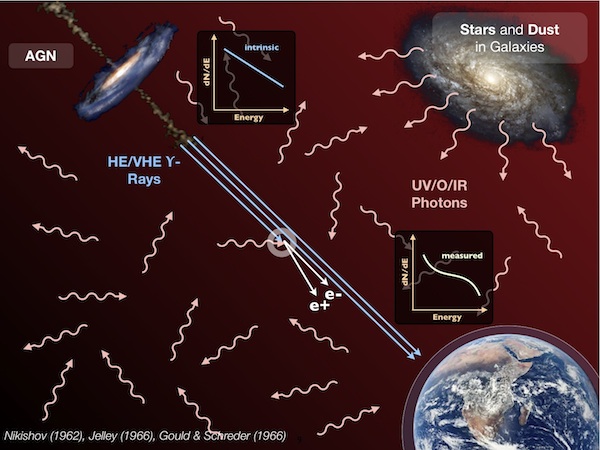Cosmic radiation fields and search for dark matter
LEXI Young Investigator Group - University of Hamburg
Research
Extragalactic Background Light

Very high energy gamma-ray get attenuated by interactions with the EBL. (Credit: Martin Raue 2011)
The extragalactic background light (EBL), the diffuse photon field from the optical to the infrared, contains unique integrated information about the evolution of galaxies from very early times up to the present. The spectral energy distribution is not known accurately, especially in the near- and mid-infrared range. Upper limits and absolute measurements come from direct observations which might polluted by foreground emission, while indirect upper limits can also be set by observations of high energy gamma-ray sources. Galaxy number counts integrations of observable galaxies, missing possible faint sources, give strict lower limits.
In our group we study how to limit the EBL density through measurements of very high energy gamma-rays from distant objects. With the help of such limits we investigate the properties of sources producing the EBL like the first stars (PopIII stars) or Dark Stars (see below).
Dark Stars

Illustration of a dark star. (Credit: Tanja Kneiske 2010)
Recently, it has been proposed that self-annihilating dark matter could a a strong effect on the formation and development of the first stars in the universe. In such a model, the energy release from self-annihilation of dark matter particles is the main power source of these young stellar objects called Dark Stars (DS). Therefore their features (e.g. luminosity, temperature, stellar lifetime) differ from normal Population III stars and therefore makes them distinguishable from them. The main idea for this group is to simulated the contribution of DS to the extragalactic backgroundlight considering multiple initial parameters. By comparing the results with existing data of the EBL we can derive first observational limits on Dark Stars in the early universe which will surely be improved with upcoming new data. This calculations are done in collaboration with the Observatory Hamburg .
High energy extragalactic backgrounds
Extragalactic background radiation has been observed all across the electro-magnetic spectrum from radio to gamma-rays. The origin of the high energy part, X-ray and gamma-ray energies, is mainly due to active galactic nuclei and galaxies, but contributions from dark matter are also possible. Analysing recent data and theoretical modeling will be done in this group as well.